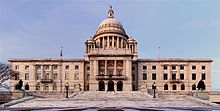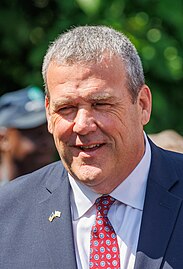The government of California is the governmental structure of the U.S. state of California as established by the California Constitution. California uses the separation of powers system to structure its government. It is composed of three branches: the executive, consisting of the governor of California and the other constitutionally elected and appointed officers and offices; the legislative, consisting of the California State Legislature, which includes the Assembly and the Senate; and the judicial, consisting of the Supreme Court of California and lower courts. There is also local government, consisting of counties, cities, special districts, and school districts, as well as government entities and offices that operate independently on a constitutional, statutory, or common law basis. The state also allows direct participation of the electorate by initiative, referendum, recall and ratification.
The government of the U.S. state of Ohio consists of the executive, judicial, and legislative branches. Its basic structure is set forth in the Constitution and law of Ohio.

The government of Maryland is conducted according to the Maryland Constitution. The United States is a federation; consequently, the government of Maryland, like the other 49 state governments, has exclusive authority over matters that lie entirely within the state's borders, except as limited by the Constitution of the United States.

The government of Alabama is organized under the provisions of the 2022 Constitution of Alabama. Like other states within the United States, Alabama's government is divided into executive, judicial, and legislative branches. Also like any other state, these three branches serve a specific purpose in terms of power.

The government of the U.S. State of Oklahoma, established by the Oklahoma Constitution, is a republican democracy modeled after the federal government of the United States. The state government has three branches: the executive, legislative, and judicial. Through a system of separation of powers or "checks and balances," each of these branches has some authority to act on its own, some authority to regulate the other two branches, and has some of its own authority, in turn, regulated by the other branches.

The Government of Colorado is organized into three branches: the executive branch of the Governor, the legislative branch of the General Assembly, and the judicial branch of the Supreme Court and lower courts. This government was created by the Constitution of the State of Colorado, and allows for direct participation of the electorate by initiative, referendum, recall and ratification.

The government of the U.S. state of Oregon, as prescribed by the Oregon Constitution, is composed of three government branches: the executive, the legislative, and the judicial. These branches operate in a manner similar to that of the federal government of the United States.

The government of the State of New Jersey is separated into three distinct branches: legislative, executive, and judicial. The powers of the State of New Jersey are vested by the Constitution of New Jersey, enacted in 1947, in a bicameral state legislature, the Governor, and the state courts, headed the New Jersey Supreme Court. The powers and duties of these branches are further defined by acts of the state legislature, including the creation of executive departments and courts inferior to the Supreme Court.
Utah is a state in the United States of America. Its government consists of a state executive, legislative, and judicial branch, laid forth by the Constitution and law of the State of Utah.
The Government of the Commonwealth of Pennsylvania is the governmental structure of the Commonwealth of Pennsylvania as established by the Pennsylvania Constitution. It is composed of three branches: executive, legislative and judicial. The state capital of Pennsylvania is Harrisburg.
The government of Virginia combines the executive, legislative and judicial branches of authority in the Commonwealth of Virginia. The current governor of Virginia is Glenn Youngkin. The State Capitol building in Richmond was designed by Thomas Jefferson, and the cornerstone was laid by Governor Patrick Henry in 1785. Virginia currently functions under the 1971 Constitution of Virginia. It is Virginia's seventh constitution. Under the Constitution, the government is composed of three branches: the legislative, the executive and the judicial.
In the United States, state governments are institutional units exercising functions of government at a level below that of the federal government. Each U.S. state's government holds legislative, executive, and judicial authority over a defined geographic territory. The United States comprises 50 states: 9 of the Thirteen Colonies that were already part of the United States at the time the Constitution took effect in 1789, 4 that ratified the Constitution after its commencement, plus 37 that have been admitted since by Congress as authorized under Article IV, Section 3 of the Constitution.

The government of Indiana is established and regulated by the Constitution of Indiana. The state-level government consists of three branches: the judicial branch, the legislative branch, and the executive branch. The three branches share power and jointly govern the state of Indiana. County and local governments are also constitutional bodies with limited authority to levy taxes, pass legislation, and create and maintain local public infrastructure.

The government of the U.S. state of Kansas, established by the Kansas Constitution, is a republican democracy modeled after the Federal Government of the United States. The state government has three branches: the executive, the legislative, and the judicial. Through a system of separation of powers, or "checks and balances," each of these branches has some authority to act on its own, and also some authority to regulate the other two branches, so that all three branches can limit and balance the others' authority.

Michigan has a republican form of government with three branches of government: the executive branch consisting of the governor of Michigan and the other independently elected constitutional officers; the legislative branch consisting of the House of Representatives and Senate; and the judicial branch consisting of the one court of justice. The state also allows direct participation of the electorate by initiative, referendum, recall, and ratification.
The government of Nevada comprises three branches of government: the executive branch consisting of the governor of Nevada and the governor's cabinet along with the other elected constitutional officers; the legislative branch consisting of the Nevada Legislature which includes the Assembly and the Senate; and the judicial branch consisting of the Supreme Court of Nevada and lower courts.
The government of New Mexico is the governmental structure of the state of New Mexico as established by the Constitution of New Mexico. The executive is composed of the governor, several other statewide elected officials and the governor's cabinet. The New Mexico Legislature consists of the House of Representatives and Senate. The judiciary is composed of the New Mexico Supreme Court and lower courts. There is also local government, consisting of county administrations, city governments, and special districts.

The Government of Tennessee is organized under the provisions of the 1870 Constitution of Tennessee, first adopted in 1796. As set forth by the state constitution, administrative influence in Tennessee is divided among three branches of government: executive, legislative, and judicial.

The government of North Carolina is divided into three branches: executive, legislative, and judicial. These consist of the Council of State, the bicameral legislature, and the state court system. The Constitution of North Carolina delineates the structure and function of the state government.
In the United States, each state and territory has constitutional officers who lead the state governments of the United States. These officers may be elected or appointed, depending on the position. The number and powers of state constitutional officers varies from state to state, based on the constitution and statutes of each state. State constitutional officers may reside in the executive or legislative branch, while state constitutions also establish the judicial system of the state, including state supreme courts.



















